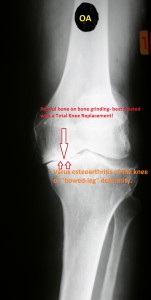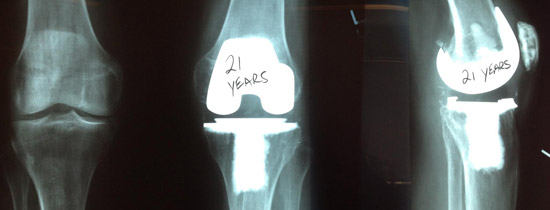Total Knee Replacement Precautions and Allowed Activities
Stuart C. Kozinn MD / Scottsdale Joint Center / www.scottsdalejointcenter.com
If you have been told the only way to get rid of your burning, grinding, bone-on-bone knee pain is a “Knee Replacement” , you are reading the right article! This is now one of the most common and successful orthopedic operations in the USA. Over a half million knees are done every year. It is predicted there will not be enough surgeons to do all the necessary total knees in the next decade. Osteoarthritis of the knee is rising at an “epidemic” rate, just as patients are demanding a more active life style. Now younger patients in their forties and fifties are more common total knee candidates. In some countries that have a national health service ( like Canada) there is a back up and delay of the number of people who need knee replacement but can’t readily get it. Partial knees have different activity rules; I let them do a bit more than my total knees. This is not because partial knees can’t eventually fail, but because they are easier to re-do if a problem develops. Also the partial knees retain a normal ACL and PCL, thereby having a more natural ligament balance and increased strength to withstand sprains and strains.
 Figure 1: varus osteoarthritis of the Knee
Figure 1: varus osteoarthritis of the Knee
So what can you actually do with your new Total Knee?; and probably more important what activities CANT you do?. In a perfect world; (without lawyers and possible liability for implant failures), we might let total knee patients do “anything they wanted to”. It is possible to run and play basketball with a total knee. However, we have to “over treat” everybody with a total knee to prevent some failures, even though some patients might be able to safely do more things. A thin, very fit woman would likely do better playing fast singles tennis then an overweight, out of shape orthopedic surgeon. In fact, some of my patients choose to run, play basketball and racquetball against my general medical advice. In my 25 year personal experience the vast majority of these “non-compliant” (spirited/adventurous?) patients actually do very well, …much better than expected! Unlike hips, total knees do not easily “dislocate”, or come out of joint. So we are less concerned about that happening in the middle of a strenuous activity. However, we know that total knees do NOT last forever. They are little machines that will take care of you longer , if you take care of
them!
So how do total knees gradually fail? For starters, they are CEMENTED into the bone. And just like cracks form in the sidewalk over years after extremes of weather, cracks can occur in cement inside your knee. This is more likely if you “beat your knee up” on a regular basis. This is why we do not recommend running for daily exercise after a knee replacement. Long distance running is even worse. The constant repetitive “jarring” could lead to cement cracks and eventual loosening of the implant. I do let my patients play tennis (doubles is much safer), and I let them ski, wakeboard, play golf, bike ride, swim, and do similar sports. Bike riding, Yoga and swimming are the best exercises. After 25 years of doing total knees, only a very small percentage of my knees have failed for any reason. I have not seen more failures in my active people! Some patients have required revision surgery ( a do-over ). Fortunately, re-dos actually perform quite well. {Years ago I took care of a professional baseball player with a total hip replacement He wanted to play baseball again (part of it involved endorsements that would not pay out unless he played). He knew the risk, but his major question was, “If my hip fails, can you re-do it?” With a yes answer, he was comfortable playing, and it was a thrill watching him jog around the bases flawlessly after hitting a major league home run}.
Some knee failures occur after the plastic bearing (or cushion) between the metal parts has worn down over many years. The plastic particles can have an inflammatory effect on the knee, causing swelling, and some bone loss. That is why we are always searching for a better, more durable plastic. the cross linked polyethylene plastic liners we use now ARE more durable than the ones used 20 years ago. So we don’t really know how long they will last. Lab simulation wear testing suggests the plastic can last out thirty years or so. I now tell patients that 80 percent of my total knees will still be functioning well twenty years out, I just don’t know which 20 percent will have some problems. I favor the rotating platform type of knee, because i believe they will last longer. The plastic insert is free to move and rotate, and I believe this decreases the stresses applied to the plastic and the cement interfaces. i have not seen the plastic wear out yet in the rotating platform knees I have done. Interestingly enough, so far in general it has NOT been the more athletic patients that fail sooner. Active patients tend to have harder bone. I have seen the most failures in overweight post-menopausal women with soft bone. After menopause, some women develop osteoporosis, and I have seen some failures where the patient’s own weight causes the implant to “crush into” the bone, causing pain and loosening. All patients should all take calcium and vitamin supplements to keep their bone strong!










